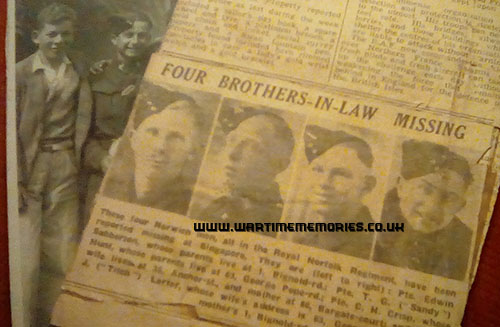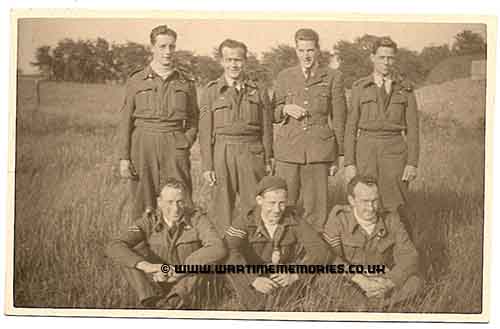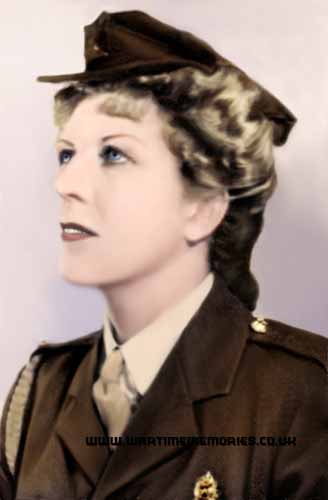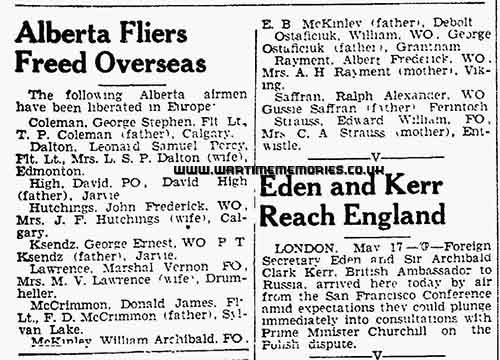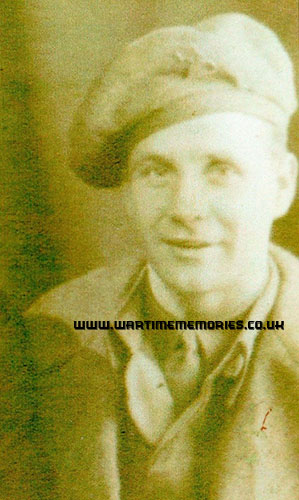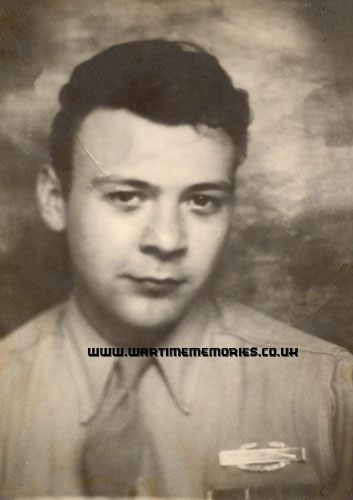|
|
|
Pte. Matt Saari . United States Army 52nd Armored Infantry Battalion from Rock Mchigan (d.28th Apr 1945) My uncle, Matt Saari was a Private with the 52nd Armored Infantry Battalion. He was captured in the battle of the Bulge and detained at Stalag 9B, barracks #28. He died 28 Apr. 1945. I know the camp was liberated on 2nd Apr 1945, but I don't know what happened to him after being liberated. I think he was too sick to recover. I do know he is buried in Normandy Cemetery, France. I don't know much about him, my mother told me he loved to play baseball. If any one has any info on him I would appreciate it.
|
Pte. Edwin Sabberton . British Army 6th Btn. Royal Norfolk My Dad's cousins, David Larter and Edwin Sabberton went missing in Singapore with the 6th Norfolk Regiment, along with their brothers in law, Tom Hunt and Horace Crisp. My dad who is on the photo with David served in the merchant navy in the war.
|
Sergeant Ronald Sidney Sabell . RAF Lancaster ED 542 106 Squadron (d.3rd April 1943)
|
W Saben . British Army 16/5th Lancers W Saben served with the 16/5th Lancers British Army. I have his unissued dogtags, made in preparation for deployment to the Far East and would love to get them home to his family. I am happy to cover all costs. If you are a family member or can put me in touch with them please get in touch. Update: Unfortunately The Wartime Memories Project has lost touch with Dan, his website, facebook page and email have all ceased to function. But if you can add any details about the person listed, please use the add to record link below.
|
Ld/Tel. Donald Sabin . Royal Navy HMS Vetch (d.4th February 1944) Leading Telegraphist Donald Sabin served on HMS Eagle from 1939 to 1941. Then we lose track of which ships he was on until he joined HMS Vetch in Alexandria in late 1943. He died of smallpox on 4th February 1944 and is buried in Gibraltar (North Front) Cemetery, Plot 1, Row D, Joint Grave 7. Can anyone fill in the gaps in his record of service please?
|
DA Sach . British Army DA Sach served with the British Army. I have his unissued dogtags, made in preparation for deployment to the Far East and would love to get them home to his family. I am happy to cover all costs. If you are a family member or can put me in touch with them please get in touch. Update: Unfortunately The Wartime Memories Project has lost touch with Dan, his website, facebook page and email have all ceased to function. But if you can add any details about the person listed, please use the add to record link below.
|
Ord. Sea. Albert Sadler . Royal Navy Fleet Air Arm HMS Pembroke from York, Yorkshire
|
F/Lt.. Anthony Graham Sadler . Royal Air Force 100 Squadron from Guildford Tony was shot down on July 13th 1943 at about 0700 hrs over Brest. He was piloting a Lancaster Bomber EE 183 HW-P that had returned from a bombing raid on the Turin railyard, they were based at RAF Waltham (Grimsby)
His crew members were ;
- A G Sadler 148132
- J Egleston 1487782
- M J Maloney 1031746
- W E Broxup 657446
- R A A Howe 657446
- R R W Parker 158598
- A Burton Aust 413527
EE 183 came down below 1000 ft to get a visual as their instruments were damaged by an electrical storm earlier, they were supposed to land in Cornwall, refuel and retun to Waltham, unfortunately Cornwall turned out to be France! Not just any bit of France, but Brest one of the most heavily fortified harbours in Europe.
Machine gun fire opened up on them from a fighter, then all hell broke loose, ack ack, heavy machine guns, the works, now coming from the ground, 2 engines caught fire and the plane was well alight. Tony ordered the crew to bale out, unfortunately the rear gunner was trapped in his turret and badly wounded. Tony changed the order and started looking for somewhere to land. Bob Parker the upper gunner spotted an airfield a short distance away, this turned out to be Guipavas. Guipavas in 1943 was occupied by a German fighter squadron, and this was the airfield Tony landed on. Hydraulic fluid was now all over the cockpit windscreen making visibility very poor. Bob gave Tony instructions from his position to aid the landing. They were still been fired on, and a third engine caught fire, as was most of the aircraft. Bob said bullets were flying past him missing him by inches. Bob was very lucky and was the only person not wounded, even the mascot got its nose shot off! The plane landed but with no hydraulics. Tony swerved the plane round causing the undercarriage to collapse, but stopping the Lanc. before it hit a hanger. The Lanc burnt out on the airfield, totally destroyed. All the crew got out, wounded, apart from Bob, but safe. They were all made POWs, Tony was taken to hospital in Paris for a month, recovering from a wound in his leg. He then went to Barth Stalag Luft 1, from 23/8/43 to 1/11/43, he was then moved to Stalag Luft 5 in Hyderkrug from 4/11/43 to 10/4/44. Then on 13/4/43 he was transfered to Sargan (Zagan) Staluft luft 3, Tony stayed here until the Great March as the Russians approached Sargan, and was moved out 28/1/45. Tony finally ended up at Tarmsted and was liberated on 7/4/45 and retuned to UK. It would appear that none of the crew ever met up again, all were interned in different camps,and all went their own ways after the war.
|
F/Lt. Anthony Graham Sadler . Royal Air Force 100 Sqd from Guildford My father Anthony Sadler piloted EE183, a Lancaster Bomber, out of RAF Waltham/Grimsby on July 12 1943. They were shot down after returning from a bombing raid on the Turin railyards.
Dad crash landed EE183 on a German airfield near Brest. The crew all survived but all were wounded. Dad first was taken to a Luftwaffe hospital in Paris, 14/7/1943 to 18/8 /1943. After a month he was sent to:
Stalag Luft 1 Barth 23/8/1943 to 1/11/1943 then
Stalag Luft 6 Hyderkrug 4/11/1943 to 10/4/1944 then
Stalag Luft 3 Sargan 13/4/1944 to 28/1/1945 then after the Long March
Stalag Luft 3 Tarmstedt 3/2/1945 to 7/4/1945
Shortly after this he returned to the UK.
I have no information on anyone who knew Tony in Stalag Luft 3 or on the Long March. Any information gratefully received.
|
E Sadler . British Army West Yorkshire Regiment E Sadler served with the West Yorkshire Regiment British Army. I have his unissued dogtags, made in preparation for deployment to the Far East and would love to get them home to his family. I am happy to cover all costs. If you are a family member or can put me in touch with them please get in touch. Update: Unfortunately The Wartime Memories Project has lost touch with Dan, his website, facebook page and email have all ceased to function. But if you can add any details about the person listed, please use the add to record link below.
|
Spr. John Sadler . British Army 2 Constr. Coy. Royal Engineers from Smethwick, Staffordshire. (d.30th March 1944) Sapper Sadler was the Son of George Arthur and Anne Sadler, of Smethwick, Staffordshire.
He was 23 and is buried in the Izmir (Bornova) British Protestant Cemetery, Grave 166, in Turkey.
|
Pte. Joyce Sadler . Auxiliary territorial Service 904 AA (M) Transport Coy Royal Army Service Corps from Salford, Lancashire Joyce Saddler served with 904 AA (M) Transport Coy RASC
She enlisted at Manchester on 30/3/1942 giving her trade on enlistment as Theatrical
My mother was born 30th Jan 1920 at Salford, Lancs. From 1939 she was employed in the theatrical trade as a dancer/singer and was a regular member of a troupe that toured around the country.
On the 16th of April 1941 she had been performing a matinee at the Rex theatre in High Wycombe with the star of the show Al Bowlly, with whom she was great friends, at the close of the matinee she was asked by the theatre management if she would stay for the evening show to replace one of the other girls who had called in sick.
Although arrangements had been made to join Al Bowlly at his residence in Dukes court, Piccadilly my mother decided to remain at the theatre for the evening show. Al Bowlly however was killed that night when a German land mine exploded next to his residence killing him instantly.
Though I never asked if this was the reason she enlisted I am sure it must have had some bearing on her decision. Her Service Book records she was awarded her Service Chevron to drive 3 ton army transport vehicles and later awarded 'Skill at arms badge', she was discharged on the 14th Oct 1945.
She eventually emigrated to Western Australia where she died on the 1st Oct 1977.
|
Lester Sadler . United States Army from Olmsted Falls My uncle, Lester Sadler, was a prisoner of war in Stalag IXB, Bad Orb. He died while a prisoner. My father, Gilbert Sadler, was in the unit that released the camp and did not know of his brother's death until arriving at the camp. He looked for Lester and told his captain he couldn't find him; so at that point he knew something had happened. They located Lester's body and it was shipped back to the States for military burial.
|
Act.Grp.Capt. William Robert Sadler . Royal Air Force 142 Squadron from Newmarket, Cambridge My late father, Group Captain William Robert Sadler, was posted to 142 Squadron RAF to command on 24/9/40 and remained with the squadron until 4/7/41 when he moved to HQ 1 Group. During his time with 142 Squadron, at Binbrook and Eastchurch, he oversaw the conversion to Wellingtons from Battles, the training of the squadron in night bombing, and then led it on raids on four occasions (flying Q for Queenie). When the Wellingtons arrived he found that no thought had been given to training captains of aircraft in how to captain a multi-crew aircraft where the crew was dispersed and members could only keep in touch by intercom. He, therefore, typed and carbon copied his own manual to all captains, and I believe Group later showed an interest in this and that it formed the basis for the official RAF manual. I still have a copy of his original, photos of him and his air and ground crews, some of the red, white and blue ribbon he flew from his wireless antenna, and his log books and clippings from newspapers about raids. My father survived the war, unlike sadly the rest of his crew who perished after his posting. After I was born in 1943, my father was posted to Turkey to teach at the Air Staff College, and to work to keep Turkey out of the war on the Axis side. After VE Day he returned to Binbrook as station commander, and I can remember being in my pram with Lancasters taking off overhead, and three German POWs working around the house; one gave me a wooden model of a Lancaster for my third birthday. My father then went to Copenhagen as Air Attache, to Andover as Deputy Chair of the RAF Officers Selection Board, and to Washington with the NATO Joint Chiefs of Staff Intelligence Group. He retired from the RAF in 1954 to devote the rest of my life to painting. He painted professionally and successfully for another 46 years, dying in 2001 a few weeks after his last exhibition. We try to have at least one exhibition of his paintings every year.
|
W/O. Ralph Alexander Saffran . Royal Canadian Air Force 429 (Bison) Squadron from Ferintosh, Alberta, Canada Warrant Officer Ralph Saffran, RCAF, was shot down on 20th of December 1943 in a Halifax bomber and taken prisoner by the Germans. Newspaper accounts from the Lethbridge Herald (Alberta, Canada) dated 17 May 1945 record he and 11 other fliers from Alberta, Canada had been liberated in Europe. Upon liberation he returned to England and married his sweetheart, Gladys Marie Baldwin in June 1945. The couple then returned to Ferintosh, Alberta, Canada to the family farm. He lived a long life and passed away 7 February 1985 in Camrose, Alberta, Canada.
|
Barbara "Mollie" Sage . Women's Land Army Barbara Sage, known as Mollie, worked at Chestnut Street Farm, Borden, Sittingbourne in Kent.
She enlisted in the Land Army in April 1942 and served until the Land Army was disbanded in November 1950. She continued to work on the same farm for the rest of her life. She died in 1996 at the age of 87.
|
WH Sage . British Army WH Sage served with the British Army. I have his unissued dogtags, made in preparation for deployment to the Far East and would love to get them home to his family. I am happy to cover all costs. If you are a family member or can put me in touch with them please get in touch. Update: Unfortunately The Wartime Memories Project has lost touch with Dan, his website, facebook page and email have all ceased to function. But if you can add any details about the person listed, please use the add to record link below.
|
LAC William Charles Sage . Royal Air Force from Berkeley, Gloucestershire
|
F/O William A. Sage. . 428 Sqd.
|
RM Sagrott . British Army RM Sagrott served with the British Army. I have his unissued dogtags, made in preparation for deployment to the Far East and would love to get them home to his family. I am happy to cover all costs. If you are a family member or can put me in touch with them please get in touch. Update: Unfortunately The Wartime Memories Project has lost touch with Dan, his website, facebook page and email have all ceased to function. But if you can add any details about the person listed, please use the add to record link below.
|
Pte. Sandi Saidi . British Army King's African Rifles (d.3rd October 1945) Private Saidi is commemorated on the Lubudi Memorial in the Congo.
|
Pte. Sandi Saidi . King's African Rifles (d.10th October 1945) Private Saidi is commemorated on the Lubudi Memorial in the Congo.
|
Beryl Saines . Women's Land Army
|
Pte. George Arthur Herbert Sainsbury . British Army 6th Btn. Royal Norfolk Regiment from Dwell Surrey George Sainsbury served with the 6th Royal Norfolk Regiment.
|
Pte. John Owen Saint . British Army 2nd Btn. Kings Regiment (Liverpool) from Northop Hall, Flintshire (d.15th September 1944) Owen Saint is remembered on Northop Hall Village War Memorial in Flintshire. He died on 15th of September 1944 at the Battle of Coriano Ridge, Italy aged 23 years. He was one of four young men who died during WW2 that lived in Brookside Crescent (a tiny cul-de-sac in the village). Villagers are compiling information about each serviceman named on the Memorial the findings will be published and circulated throughout the village free of charge. Would love to hear from anyone who has information about the Regiment and if possible Owen.
|
Sgt. Thomas Kendle Sainthouse . British Army Thomas Sainthouse served with the British Army during WW2.
|
Pte. Joe Sainty . Royal New Zealand Army My dad, Joe Sainty was a POW for most of WWII. He was captured in Greece in 1941 and his POW number was 2471. He was interned in Stalag 18a, Wolfsberg/Karnton.
|
S/Sgt. Louis Nick Saites BSM. US Army Co. B, 1st Btn. 10th Infantry Regiment from Lansing, Michigan, USA Thirteen months before Pearl Harbor was attacked, my father Louis Saites joined the Army at the age of sixteen. Life at home was not always easy and that prompted Louis to join the Army. He didn’t have his father’s permission, which was required, so he lied about his age. He needed proof of age and he offered his Greek baptismal certificate, which he had altered. He changed his birth year to make himself two years older. Despite the poor job he did in amending the date, the Army accepted it. So at sixteen, he was a private in the United States Army assigned to the 5th Infantry Division, 2nd Infantry Regiment, 2nd Battalion, Co. G.
Louis was 18 when he was assigned to an intelligence unit in Reykjavik, Iceland. He arrived on 16th of September 1941. His job in intelligence was to befriend and get close to Icelandic persons who were suspected of spying for the Germans. Investigating one specific suspect proved very difficult. Louis went to great lengths to discover what he could about the man's activities, even dating the man's daughter while trying to gain entrance to their house. When he was still unable to get into the house, Louis decided to marry the daughter. Finally gaining entrance to the suspect's home, Louis was able to confirm the man was indeed aiding the Germans as a spy.
On 20 August 1942, Louis was reassigned to the 5th Infantry Division, 10th Infantry Regiment, 1st Battalion, Co. B and remained in intelligence. The 5th Division was transferred to the European Theater, and his military records show that he arrived in England on 8th of August 1943.
In England and later North Ireland, his work in intelligence was searching for German sympathizers among his fellow soldiers. He felt good that none was ever found. During the two years he was in Great Britain, he also participated in infantry training as the U.S. and the British prepared for the D-Day invasion.
The 5th Infantry Division landed in Normandy on Utah Beach on 10th of July 1944. Over the next several weeks, the 5th Division participated in numerous successful attacks, advancing from Normandy to Reims and seizing the city on 30 August 1944. The last battle that Louis fought in was the Battle of Fort Driant. It was during the Battle of Fort Driant that Louis, now a 20-year old staff sergeant, was captured on 7th of October 1944. He had been wounded and had shrapnel in his leg when he took refuge with a group of fellow soldiers. They were hiding in a small bunker built into the side of a mound of earth when they were overtaken by a tank command and forced to surrender.
As a prisoner of war, Louis was initially processed at Stalag XII-A in Limburg, Germany. He was interrogated and assigned prisoner number 93244. It wasn’t long before he was shipped by train to Stalag III-C in Alt-Drewitz, Brandenburg, Prussia, now Poland. They travelled in cattle cars that were so full they were all forced to stand the entire way. Life at Stalag III-C was a very difficult experience. It was at this camp that he was not only interrogated but also tortured. Conditions at the prison were very bad. They had little to eat, and what food they did get was awful. They ate weeds, bugs, and mice to augment their diet. Housing was in wooden buildings with very little heat and they were given only one blanket for protection against the harsh winter. After several months of internment, the prisoners learned the Soviet Army was approaching and the Germans were planning to move the prisoners towards Berlin.
On the 30th or 31st of January 1945, the Russian Army was nearing the prison camp and the Germans forced the prisoners out of the camp. They were on a forced march when they were suddenly fired upon by the Russians. Louis and another man were near the end of the line of prisoners and took advantage of the chaos to run into the woods. They were able to make their way to a farm and the Polish farmer gave them a couple of bicycles. Travelling away from the camp, they finally met up with the Russian Army and travelled with them to Odessa. After a long period of travelling from Odessa to Egypt, to Malta, to France, and then to Naples, Italy, he was finally sent home.
His military records note that he participated in three European Campaigns: Normandy, North France, and Rhineland. He also received his first Combat Infantry Badge. After a 59-day furlough at home in Lansing, Michigan, he returned to duty and was honorably discharged on 10 July 1945. He reenlisted on 10th June 1946 and remained in the Army until retiring in 1962.
During his service Louis earned the following: Bronze Star, Purple Heart, Air Medal, Army Commendation Medal with Oak Leaf Cluster, Army Presidential Unit Citation (2), Prisoner of War Medal, Army Good Conduct Medal, American Defense Service Medal, American Campaign Medal, Europe/African/Middle Eastern Campaign Medal with 3 Bronze Battle Stars, World War II Victory Medal, Army of Occupation Medal 1945-1990, National Defense Service Medal, Korea Service Medal with 2 Bronze Service Stars, Armed Forces Reserve Medal, and United Nations Service Medal. In addition, he received two Combat Infantry Badges and eight Overseas Bars.
|
Cpt. Basil Stewart Sakier . British Army Royal Welch Fusiliers from london My father Basil Sakier died when I was 11. He never spoke of the war in Burma to me, but I was later told he had served in Burma. Then he suffered with nightmares as many comrades had died in the jungle warfare. He was 18 when the war started, 24 when over. I have a badge of his from his uniform. I have tried to trace anyone who knew him, but with no luck. Combination of age, he would be 93 had he lived, and not enough knowledge.
|
|


